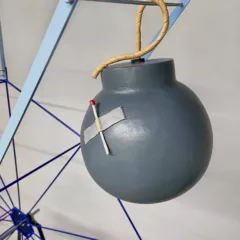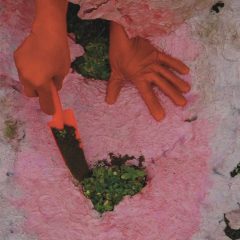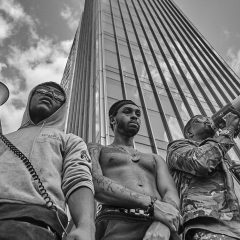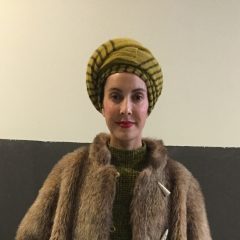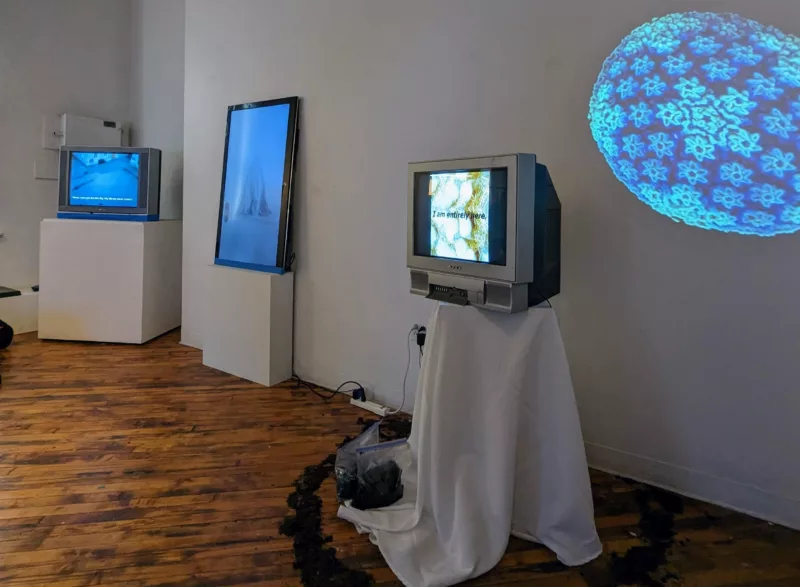
It all started with a couple of bad critiques in graduate school.
Show curators Jazmyn Crosby and Quinton Maldonado gravitated towards each other during their time at Tyler School of Art and Architecture, bonding over their mutual interest in experimental sound art. It turned out that they also share similar upbringings that left them imprinted with a lasting sense of techno-skepticism. I was able to speak to both curators at Practice Gallery (319 N 11th St, 2nd Floor) about their curated show echo broadcast, which opens this Friday, September 8th and runs through September 30th.
The gallery is dimly lit to help best view a group of glowing monitors and television sets around the room, rather like silent sentinels. There is a purposeful mix of newer and older models of monitors and televisions- most of the artists requested one or another. The hardware choices are not just aesthetic, but also speak loudly to the themes of the show; Upon a light digestion, I believe this show is about technophobia, but only insofar as that phobia is a reflection of our anxieties about persistence as real humans and about the persistence of our memories.
The show grew not only out of the relationship between Crosby and Maldonado, but out of the direct impact and conversations that they- and we all – had about technology and the pandemic. I’m saying “we all” because I cannot imagine any person who lived through the first parts of the pandemic that never had a moment of reflection on their connection to other humans and how the old ways we would regularly connect were suddenly ripped away. It is a little bit fascinating to see all the art and other projects that are coming to fruition in 2023 that are reflections of the isolation and uncertainty of 2020. In fact, echo broadcast is the physical result of an unfinished thesis written by the two curators. Maldonado shared some of his thoughts with me about this end product. He talked about the impermanence of the future- like how he just got a new computer that has no CD drive, which reduces or eliminates the ability to interface with certain content.
Our technological overlords have decided that the vagary of “the cloud” is an acceptable exchange for the theoretical availability of EVERYTHING on the internet or via streaming, but in doing so have incentivized the tragic loss of cultural product. Remember when our species used to record our history in literal stone? Now we are often only reminded of what the algorithms of our phones are taught might be important to us. It is a notion that is specifically addressed by artist Jenny Vogel in her work “All Things Already Lost”, and is also written about in an attractive risograph booklet that is available for sale in the gallery.
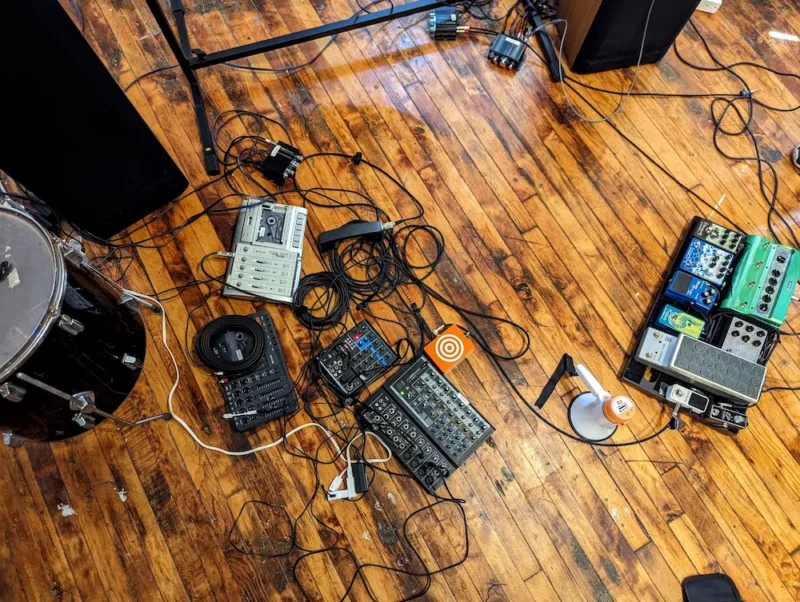
The tenuousness of memory and the degradation of history and technology is also addressed by musician Joshua Marquez in his work “Cutting Through Static.” I was able to meet Marquez during my gallery visit. He described himself as a musician, not a visual artist, but to me, it looks like he’s sliding into an art practice that, perhaps, he just hasn’t realized is happening yet. In a corner of the gallery, Joshua has set up a grouping of self-constructed speakers and invented instruments that will play his written score throughout the gallery show, but also during 2 performances on September 8th at 7pm, and again on September 21st. There’s a great quantity of cables and pedals on the floor, a telephone handset, and two string bows all ready to be used during the performances.
The sounds of the piece are all filtered, and sometimes re-filtered through things that are not filters, and amplified using sound exciters to create speakers out of other musical instruments. Marquez described the feeding back of the feed back to the way that we are often constantly refreshing pages, scrolling, swiping; the looping back and back and back saturates us with an anxiety for everything and becomes un-understandable. The literal degradation of the plastic film used in cassette tapes over hundreds of plays is the analogy of this work.
While Marquez is working on the break-down of plastics, Charlotte G. Chin Greene is thinking about their permanence in both our environment and our bodies. Greene’s work is the only work in the show that does not have either a sound component, a digital screen, or both. It was a smart choice by the curators to include their work to help the viewer re-ground themselves amid all the digital disquiet. Greene’s future artifacts help remind us that even though our digital histories are likely to be lost, our choices about material usage are likely to be around forever.
Oglála Lakȟóta artist Suzanne Kite shows a video titled “Pȟehíŋ kiŋ líla akhíšoke (Her hair was heavy),” a self portrait of the artist wrestling with a 50 foot braid of hair. The manipulation of the braid controls a computer that spits out AI generated words as she moves. The thing that really fascinated me about this piece was my ability to tune out the AI language but latch on to her performance and the music-ambient background. Are we all getting a little bit too used to the pervasive noise of our own intrusive thoughts? Kite also shows a work which she collaborated on with a group of artists and technologists called the LA Birdwatchers about aerial surveillance- something else that has become pervasive and mundane in our society. The work is not just art, but has actually been used to bring a lawsuit against the Los Angeles Sheriff’s department over surveillance and privacy issues.
Meredith Haines’s work appears at first to be about the biological part of the pandemic, but don’t get confused. “1 in 2” is actually about sexually transmitted infections and the stigma surrounding them. An image of what we have come to recognize as the cell of disease is projected on the wall behind a TV showing microscopic views of skin, overlaid with the message “I am entirely here.” I questioned the placement of a white sheet over the pedestal on which the TV sits, and Crosby explained that it is purposeful- it alludes to sanitization, perhaps a clean, white hospital sheet. The ring of dirt around the work is both representative of the perceived contamination of disease, and the barrier that keeps the disease contained- the myths of contamination and vitality.
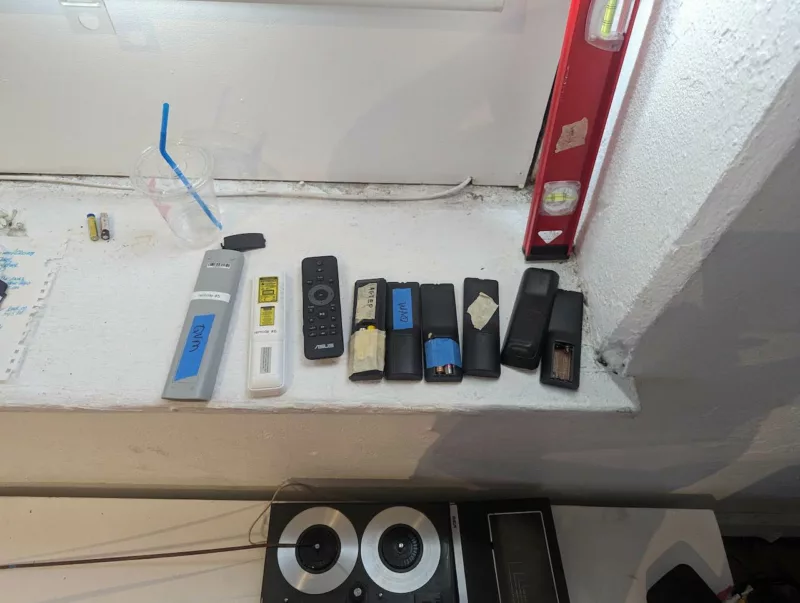
I was shown towards what looks a little bit like a computer workspace, but is actually a presentation of the joint project “Quarantine Public Library” by Katie Garth and Tracy Honn. Launched during the summer of 2020, the team invited artists to submit one page zines to be included in this extensive archive. The digital archive is more of the ethereal cloud content that give Crosby and Maldonado pause, but in the gallery, the viewer is invited to sit and browse the archive, and print off and construct any zine that they like and keep it in their own physical library. One could spend many hours here exploring all the zines, but you can also explore from your own internet connected device by visiting https://www.quarantinepubliclibrary.com/. Honn and Garth realize the paradox, but note that it is central to the library’s existence.
I think echo broadcast does an excellent job at examining our techno anxieties without assaulting the delicate compartments of our brains that are keeping those things from overtaking our existence. That’s how I feel, anyway. I’m always desperately holding back a flood of the water and detritus of the last 6 or 7 years. We cannot break down the complex trauma of our techno-saturated, post pandemic world without addressing it. We have to allow ourselves to think about the terrible past and the possibly more terrible future. Maldonado said “it’s all mundane until the eye of Sauron turns its gaze upon you”, whether we are being watched or feeling isolated. If we want to be self actualized, or even just remembered, we have to put a light on the things that are churning within us.
The opening reception for echo broadcast was Friday, September 8th from 6 to 9pm, with performance at 7pm. I’d like to suggest that you visit during gallery open hours where you can spend real time viewing and considering the work.
An artist panel was held at Vox Populi’s Black Box on Saturday, September 9th from 6 to 9 pm.
Down the hall from Practice, visit Iffy Books for related programming, and look out for other special programming by Lino Kino and Sound Museum Collective. echo broadcast is open at Practice Gallery until Sept. 30.


